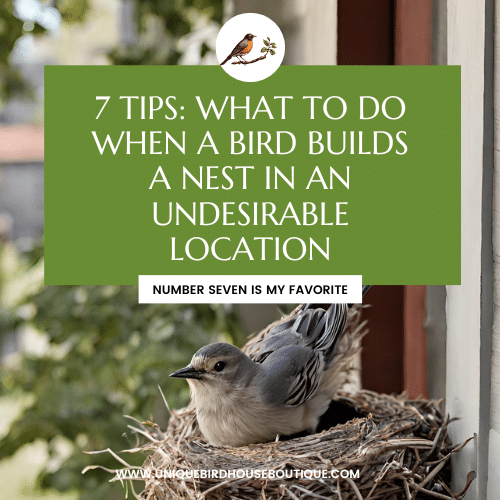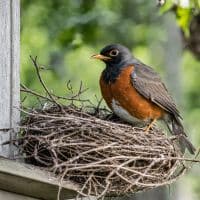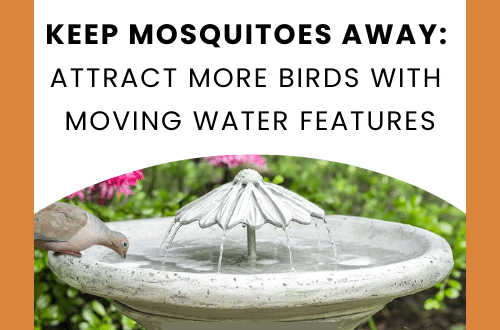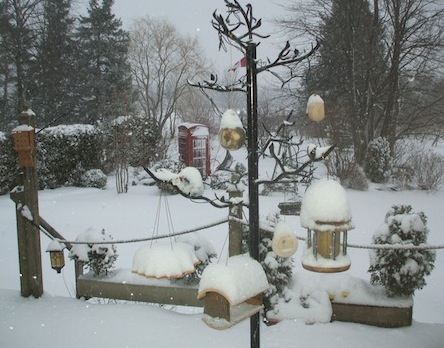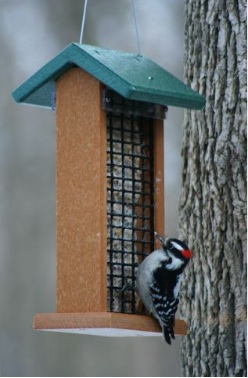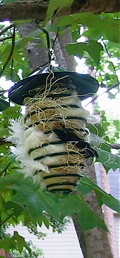-
Seven Tips: How to Handle Unwanted Bird Nests on Your House
A bird has built a nest in an undesirable spot on your house, front porch, window ledge, back door or really any inconvenient place close to your house, now what?
We’ve all been there. One morning you walk out your front door and see a bird darting back and forth, carrying twigs and grass. When you return home, there is a full-blown nest right above your front door. At first it can be quite charming, however several days pass and you are attacked by a protective mama bird, or you just generally don’t enjoy all the shall we say “droppings” left behind. Whatever the reason, there are some do’s and don’ts of managing the inconvenient nesting situation.
First, the good news. The nesting period is not forever, and some species may only be a matter of weeks. The nesting cycle for most songbirds is around 4 weeks total, from laying of the egg to chicks leaving the nest.
- IDENTIFY. First things first, start by identifying which feathered friend has taken up residence on your porch. NestWatch has a great tool for identifying the type of bird who has built the nest, so you know what you’re dealing with.
- PROTECT. Native birds’ nests are protected. Believe it or not, there is actually a law in place (Migratory Bird Treaty Act of 1918) to protect birds and their nest nationwide. If in question, we always suggest you check with your local wildlife authority. Doing this will also give you a better idea of their nesting cycle so you can keep an eye out.
- DO NOT DISTURB. Once a bird has laid eggs in the nest, you’re out of luck. Do not touch or remove the nest. Try not to use the area around the nest until the young have fledged to ensure that the parents will not abandon their nest. If this is not possible, try to minimize your presence around the nest; many yard birds are tolerant of occasional disturbances.
- REMOVE (SOMETIMES). Keep an eye out for nest activity. After the brood has fledged and moved on, its safe to remove to nest. We suggest using gloves, as bird droppings or the nest may have harmful contaminants. Most birds only nest once a year, however birds like the American Robin, Eastern Bluebirds, House Wrens, American Goldfinch and Northern Cardinals can produce several broods a year. This makes it important to identify the type of bird. For songbirds with multiple broods in a season If the nest is in a safe location and not too terribly troublesome, please leave it be if at all possible.
- PREPLAN. Start thinking ahead on how you’d like to discourage them from nesting in the same spot next year.
- Hang a Wind Chime: Birds aren’t particularly keen on the movement and sound of the wind chimes, especially if they’re made from metal or shiny materials. This will act as a natural deterrent if placed close enough to the undesired nesting spot.
- Mount a Light: Nothing disturbs my sleep quite like light and birds aren’t too different. Flashes of bright light will deter birds from nesting in a particular area as the variation between light and shadow may signal danger.
- Install Bird Spikes: This is our least favorite option and should only be used if the nesting spot is physically dangerous for future broods. These rods are dull and will not harm the birds, but there are certainly more preferred options than this.
- PROVIDE. Giving birds a suitable place to build a house is the best way to relocate a nest going forward. If you know which type of bird was in the undesired nest, you can select a birdhouse that fits that particular birds needs. If you are ever unsure, we are always more than happy to help point you in the right direction! [email protected]
- ENJOY. Nature is one of our greatest gifts. While a nest may not be in the most ideal location, savor the moment. Try to keep in mind that new feathered friends are on the way. The joy they bring far outweighs any short-term nest location inconvenience.
-
Do More with Peanut Bird Feeders
Just a few short weeks (hopefully) and that dreary, brown, snow covered landscape will give way to lush new foliage… and it can’t come soon enough for many of us!
Feeders have been in full swing this winter with hungry birds braving the most frigid days seeking calories to keep warm. Every feeder’s seen its share of flying traffic through this most miserable season.
With bulbs forcing through, birds are already starting to nest in the southeast, we’ve already changed up two peanut bird feeders for another good use… nesting materials!
Any kind of feeder with wide openings works well. Because peanuts are still mighty beneficial to birds, using an extra suet cage is ideal for offering materials.
Here’s one of the cool things about backyard birding. Not too much is cut in stone so to speak. You needn’t buy a full-fledged peanut bird feeder to offer peanuts, nor a complete nesting material kit to offer the materials. Here’s a cool recycled 3-in-1 feeder that perfect for suet, peanuts, nesting material or even fruit in summer. Just be creative and see what works best for your birds!
That same spring feeder offers peanuts, suet, nest material, and yes… fruit in summer. Oh yeah, and the nesting materials? You can do this one yourself! Cats or dogs? Save their hair (not such a good idea if fluffy or fido has been treated with flea & tick medication). Decorative mosses are another favorite, sphagnum or sheet moss, Spanish moss, coco fibers from old plant liners too. Just be sure they’re clean. Feathers are coveted as well for some species’ nests. Again, just be sure thee have been sanitized, and use light or natural colors in the mix.
Recently cruising one of the video platforms, a big retailer’s video came up about nesting material. With lots of video views, “how dead wrong” is what came to mind. Cardinals don’t use those shelves, they nest in trees or shrubs. But I guess if you have no trees or shrubs they might use one? And they don’t use that cotton stuff either. Weed stems, twigs, bark, grasses and leaves are what make up cardinal nests in these parts… come on!
- Bird Accessories, Bird Nesting Materials, Fruit Bird Feeder, Nesting Material, Suet Feeders, Uncategorized
be ready for the season with homemade nesting materials
The cold weather of winter leaves behind some clues for us (if we look) from the previous busy season of the avian world. Simply look up and take notice. Barren-looking trees with their foliage stripped will reveal the nests of several species, and what they’ve used for nesting materials.
Large, messy nests are usually the work of squirrels, while a smaller nest consisting of twigs and grasses may be that of a Cardinal, Blue Jay, or Mockingbird. An even smaller nest with tightly woven plant fibers, maybe even some milkweed or thistle down still attached would be the work of an American Goldfinch. You’d have to search a bit harder to find nests from Bluebirds, Chickadees, or Nuthatches, as these birds nest in cavities or birdhouses. You can easily encourage nest building around your place this season by offering nesting materials before the season actually starts. Although there are many cool kinds of materials and holders available, this is most definitely a “do-it-yourselfer”!
Start by gathering nesting materials now. Feathers and pet hair are preferred by Chickadees, while decorative mosses (Spanish, Sphagnum, and that thin, curly straw-like stuff) might be used by many species mentioned above. Bright cotton yarns add a nice touch too, as variety is the spice of life. Although I’ve always heard that dryer lint is a good one… our local birds have never touched it when previously offered. Stay away from plastics, fishing line, and the like. These can get tangled around nestlings or their legs, proving to be hazardous, and sometimes fatal.
Now, what to put your nesting materials in? That part is simple! A standard suet cage works perfectly, as do the mesh produce bags from the grocery store (the kind apples come in). The
Spring Feeder shown here is just that, meant for fruit or suet. We’ve found whole peanuts and our nesting materials work great in them too. Talk about versatility! Put a mixture of materials in several holders and hang them from branches around your yard where the birds will see them. Do pull some materials through to get started, but don’t pack them in too tightly. Birds need to be able to pull them out fairly easily, and should the rain saturate the nesting material, it will dry quickly if air can flow through it. So start gathering… and here’s to many successful broods this season!

